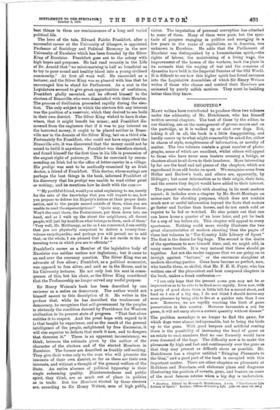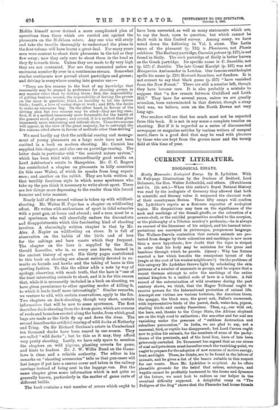SHOOTING.*
MARY writers have contributed to produce these two volumes under the editorship of Mr. Hutchinson, who has himself written several chapters. The beat of those by the editor, to our thinking, are on the management of grouse moors and on the partridge, as it is • walked up or shot over dogs. But, taking it all in all, the book is a little disappointing, and hardly comes up to what might reasonably be asked for, either in charm of style, completeness of information, or novelty of matter. The two volumes contain a .great number of photo- graphs, some of which are excellent, whilst others will appeal to those who have never seen beaters crossing a bridge, or shooters about to sit down to their luncheon. More interesting by far are the head and tail pieces of the chapters, which are reproduced from old books on sport. We recognise some from Holler and Barlow's book, and others are, apparently, by Ridinger ; but some information as to their origin, their date, and the scenes they depict would have added to their interest.
The present volume deals with shooting in its most modern aspect; it includes even a chapter by Mr. Scott-Montagu on motor-cars for shooting purposes, which does not contain much new or useful information beyond the facts that motors go faster and further than horses, and do not catch cold or require to be fed or watched. He also points out that one can leave home a quarter of an hour later, and yet be back for a cup of tea before six. This chapter will appeal to every sportsman. Nothing could more vividly illustrate the two great characteristics of modern shooting than the pag-ce of these last volumes in "The Country Life Library of Sport." The first is the desire for big bags. The second is the desire of the sportsman to save himself time, and, we might add, in many cases trouble. It is very natural that these should go together. Let not the reader suppose that we are going on to inveigh against " battues," or the enormous slaughter at modern shooting-parties. Guns have become so perfect, men, who handle them, so skilful, that Mr. F. E. R. Fryer, who has written one of the pleasantest and best composed chapters in the book, makes a frank confession :— " I can only hope that the present game gun may not be so improved on as to be able to be fired more rapidly. Even now, with a. party of good shots there is little left for a second shoot, and fond as I am of a big day, I do not think I should derive any more pleasure by being able to fire at a quicker rate than I can now. Moreover, we are rapidly reaching the limit of game preservation in this country. However favourable a soil for game, it will not carry above a certain quantity without disease."
The problem nowadays is no longer to find the game, for which dogs were almost indispensable, but to bring the birds up to the guns. With good keepers and artificial rearing there is the possibility of increasing the head of game on an estate to such numbers, that no one formerly would have even dreamed of the bags. The difficulty now is to make the pheasants fly high and fast and continuously over the guns so that they may present as difficult shots as possible. Mr. Hutchinson has a chapter entitled "Bringing Pheasants to the Gun," and a good part of the book is occupied with this important matter. There are other chapters on pheasants at Holkham and Nuneham, and elaborate plans and diagrams illustrating the position of coverts, guns, and beaters on some of the most famous estates when a big day is undertaken.
• Shooting. Edited by Horace G. Hutchircion. 2 vols. " The Country Lite Library of Sport." London; Offices of Country Life. 11.28. 6d. each vol. net.]
Moltke himself never devised a more complicated plan of operations than those which are carried out against the pheasants on the Holkham estate. Any one who will study and take the trouble thoroughly to understand the plans in the first volume will have learnt a great deal. For many years men were content to shoot their pheasants in the tail as they flew away; now they only care to shoot them in the head as they fly towards them. Unless they are made to fly very high they are not contented. Nor are they contented unless an enormous number fly over in a continuous stream. Somewhat similar sentiments now prevail about partridges and grouse ; and driving is everywhere coming into greater use :—
" There are five reasons to the best of my knowledge that reasonably may be argued in preference for shooting grouse in any manner other than by driving them : first, the impossibility of getting beaters ; second, the impossibility of driving the grouse on the moor in question ; third, an inability to hit the driven birds ; fourth, a love of seeing dogs at work ; and fifth, the desire to make an enormous bag. On the other hand, in favour of the driving plan but two reasons may be cited—they are big ones: first, it is a method immensely more favourable for the health of the general stock of grouse; and second, it is a method that gives immensely more interesting and difficult shots. These two reasons will appear, in the view of the great majority, far to outweigh the five reasons cited above in favour of methods other than driving."
We need hardly say that the artificial rearing and manage- ment of young pheasants on a large scale have not been omitted in a book on modern shooting. Mr. Cornish has supplied this chapter, and also one on partridge-rearing. The latter deals in particular with "the assisted nature system," which has been tried with extraordinarily good results on Lord Ashburton's estate in Hampshire. Mr. C. C. Rogers has contributed a chapter on pheasants in hilly countries (in this case Wales), of which he speaks from long experi- ence; and another on the rabbit. They are both written in that terribly facetious style in which some sportsmen who take up the pen think it necessary to write about sport. There are few things more depressing to the reader than this forced humour and trite manner.
Nearly half of the second volume is taken up with wildfowl- shooting. Mr. Walter H. Pope has a chapter on wildfowling afloat. He writes with enthusiasm of sport in tidal estuaries with a punt gun, at home and abroad ; and a man must be a real sportsman who will cheerfully endure the discomforts sad disappointments which this fascinating kind of shooting involves. A charmingly written chapter is that by Mr. Alex. J. Napier on wildfowling on shore. It is full of observation on the habits of the birds and of love for the saltings and bare coasts which they frequent. The chapter on the hare is supplied by the Hon. Gerald Lascelles, who is, as every one knows, learned in the ancient history of sport. His thirty pages contributed to this book on shooting are almost entirely devoted to re- marks on hounds and hawks and the taking of hares in this sporting fashion. To this the editor adds a note by way of apology, observing, with much truth, that the hare is "one of the least interesting animals to shoot, and it is for this reason that, while it is necessarily included in a book on shooting, we have given prominence to other sporting modes of killing it, to which it lends itself more interestingly." Similar remarks, we venture to add, with certain reservations, apply to the fox. Two chapters on duck-shooting, though very short, contain information that will be new to some sportsmen. The first describes duck-shooting from the Avon gazes, which are screens of reeds and branches erected along the banks, from which good bags are made as the birds fly up and down the river. The second describes the artificial rearing of wild ducks at Netherby and Tring. On Sir Richard Graham's estate in Cumberland
ten thousand ducks have been reared in one season. They are called "wild ducks" ; but be this as it may, they afford very pretty shooting. Lastly, we have only space to mention the chapters on wild pigeons, planting coverts for game, and hints to loaders. Mr. J. W. Willis Band on the Game- laws is clear, and a reliable authority. The editor in his remarks on "shooting accessories" tells us that gun-cases will last longer if put into a canvas cover and taken in the railway carriage instead of being sent in the luggage van. But the same chapter gives some information which is not quite so generally known, particularly in the matter of game carts of different builds.
The book contains a vast number of errors which ought to
have been corrected, as well as many statements which are, to say the least, open to question, but which cannot be dealt with in this limited survey. Among many, we have noted down the following in Vol. I. alone. The Latin name of the pheasant (p. 112) is Phasianus, not Phasis colchicus. The Barbarypartridge, Caccabis petrosa (p.127), is not found in Sicily. The rock partridge of Sicily is better known as the Greek partridge. Its specific name is C. Sazatilis, not (p. 127) C. Saztilis. The late Count Karolyi (p. 197) was not Hungarian Ambassador in London. Our famous ornithologist spells his name (p. 219) Howard Saunders, not Sanders. It is not correct to say that black game (p. 217) "have vanished from the New Forest." There are still a number left, though they have become rare. It is also probably a mistake to suppose that "a few remain between Guildford and Leith Hill." They have for several years, unless we are greatly mistaken, been exterminated in that district, though a stray bird was, we believe, seen on the North Downs not very long ago.
Our readers will see that too much must not be expected from this book. It is not in any sense a complete treatise on shooting. But if it is regarded as a series of disconnected newspaper or magazine articles by various writers of unequal merit, there is a good deal that may be read with pleasure by those who are kept from the grouse moor and the turnip field at this time of year.



























































 Previous page
Previous page